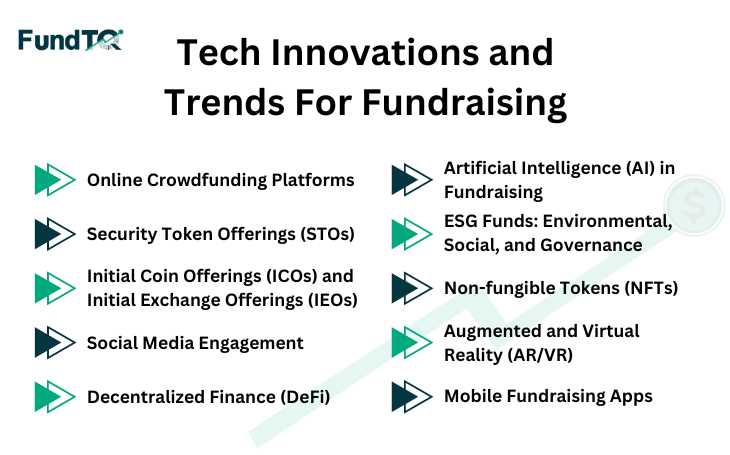Today, with technology advancing at an unprecedented rate, fundraising is undergoing a revolution of its own. Conventional fundraising methods included direct mail campaigns, phone calls, and in-person events. Today, these methods are replaced by a range of tech-dependent services designed to maximize efficiency, broaden donor reach, and improve donor experience. Developments in blockchain technology, such as programmatic crowdfunding, reciprocity-based barter fundraising, artificial intelligence (AI) blockchain fundraising, and others, point to the beginning of a new phase of digitalization in the financing industry.
This blog explores the key technological trends that are changing fundraising and enabling firms, startups, and nonprofits land, to fund their business is otherwise low in a global market like today.
Tech Innovations and Trends For the Future of Fundraising
Following are the Tech Innovations and Trends for the Future of Fundraising:-

1. Online Crowdfunding Platforms
Crowdfunding platforms such as Kickstarter, Indiegogo, and GoFundMe have revolutionized the way individuals and organizations raise funds. These platforms allow users to pitch their projects or causes directly to the public, leveraging the power of social networks to generate financial support. What was once considered a niche method for raising capital has now become mainstream, with billions of dollars raised annually through these platforms.
The future of crowdfunding looks even more promising, as emerging technologies like blockchain are being integrated into these platforms. Blockchain can provide enhanced transparency and security for transactions, allowing donors and investors to track where their money is going. The tokenization of assets, made possible through blockchain, will also allow for new ways of structuring crowdfunding campaigns, making them more flexible and accessible to a global audience.
2. Security Token Offerings (STOs)
Security Token Offerings (STOs) are poised to revolutionize the way companies raise capital. Unlike traditional Initial Public Offerings (IPOs), STOs use blockchain technology to issue tokens that represent legal ownership in an asset. These tokens can then be sold to investors worldwide, allowing companies to raise capital without going through the lengthy and costly process of an IPO.
One of the main advantages of STOs is their compliance with regulatory frameworks like the SEC in the United States. This ensures that companies raising funds through STOs are doing so in a legal and transparent manner, reducing the risk of fraud and other illegal activities. As more businesses adopt this cutting-edge technology, STOs are expected to become a major force in the fundraising world, offering a faster, cheaper, and more secure way to raise capital.
3. Initial Coin Offerings (ICOs) and Initial Exchange Offerings (IEOs)
Initial Coin Offerings (ICOs) took the cryptocurrency world by storm a few years ago, allowing companies to raise funds by selling digital tokens to investors. However, ICOs have come under increased regulatory scrutiny in recent years, as concerns over fraud and market manipulation have grown.
In response to these concerns, Initial Exchange Offerings (IEOs) have emerged as a more secure alternative. IEOs are conducted through cryptocurrency exchanges, which vet the projects and ensure that they meet certain standards before allowing them to list their tokens. This added layer of security has made IEOs a more attractive option for investors, and they are expected to play a significant role in the growth of the cryptocurrency and blockchain space in the coming years.
4. Social Media Engagement
Social media has become an indispensable tool for fundraising, allowing organizations to reach a wider audience and connect with donors and investors in real time. Platforms like Facebook, Twitter, Instagram, and LinkedIn offer businesses the ability to run targeted ad campaigns, create engaging content, and build strong relationships with their followers.
In particular, social media allows for the amplification of fundraising efforts through organic reach. By encouraging followers to share campaigns with their networks, organizations can exponentially increase their visibility and attract more donors. Moreover, social media platforms are continually evolving, offering new features like live video, stories, and interactive polls that can enhance engagement and drive donations.
As digital marketing becomes increasingly important in the fundraising world, leveraging social media to its fullest potential will be critical for organizations looking to secure capital in the future.
5. Decentralized Finance (DeFi)
Decentralized Finance (DeFi) is one of the most exciting and disruptive innovations in the financial world. By using blockchain technology and smart contracts, DeFi platforms offer financial services such as lending, borrowing, and trading without the need for traditional intermediaries like banks.
For fundraising, DeFi presents a unique opportunity to raise capital outside of the traditional banking system. Businesses can use DeFi platforms to borrow funds, issue tokens, or even create new forms of digital assets that can be traded on decentralized exchanges. The transparency, security, and accessibility offered by DeFi make it an attractive option for companies looking to raise funds in a more efficient and cost-effective manner.
As DeFi technology matures, we can expect more businesses to explore its potential for fundraising, particularly in industries where traditional financing options may be limited.
6. Artificial Intelligence (AI) in Fundraising
AI is becoming an indispensable tool for organizations looking to optimize their fundraising efforts. From automating administrative tasks to analyzing data and segmenting donors, AI can dramatically improve the efficiency and effectiveness of fundraising campaigns.
One of the most valuable applications of AI in fundraising is the ability to create highly personalized donor experiences. By analyzing donor data, AI can help organizations identify patterns and trends, allowing them to tailor their messaging and outreach efforts to specific donor segments. This not only increases the likelihood of securing donations but also helps build stronger relationships with donors over time.
Moreover, AI can be used to predict donor behavior, allowing organizations to proactively engage with donors who are most likely to contribute to their campaigns. By automating these tasks, organizations can focus their resources on high-impact activities, ultimately improving their fundraising outcomes.
7. ESG Funds: Environmental, Social, and Governance
Environmental, Social, and Governance (ESG) investing is rapidly gaining popularity among investors who want to align their financial goals with their values. ESG fundraising focuses on companies and organizations that prioritize sustainability, social responsibility, and ethical governance practices.
As more investors seek to make a positive impact through their investments, organizations that embrace ESG principles are likely to attract greater funding. This trend is particularly relevant for nonprofits and businesses with a strong commitment to social and environmental causes, as they can leverage their mission-driven focus to appeal to socially conscious investors.
In addition to attracting new sources of funding, ESG fundraising can also enhance an organization’s reputation and credibility, making it a valuable strategy for long-term success.
8. Non-fungible Tokens (NFTs)
Non-fungible tokens (NFTs) have taken the digital world by storm, offering a new way to create and sell unique digital assets. Unlike cryptocurrencies, which are interchangeable, NFTs are one-of-a-kind and can be attached to digital or real-world objects, such as art, music, or experiences.
In the fundraising world, NFTs have been used in innovative ways to raise funds for various causes. For example, organizations can create limited-edition NFTs that donors can purchase, with proceeds going towards the organization’s mission. NFTs offer a way to engage donors in a more interactive and immersive manner, making fundraising campaigns more exciting and memorable.
As the use of NFTs continues to grow, we can expect to see more organizations leveraging this technology to enhance their fundraising efforts and appeal to a tech-savvy donor base.
9. Augmented and Virtual Reality (AR/VR)
Augmented reality (AR) and virtual reality (VR) technologies are creating new possibilities for immersive fundraising experiences. With AR and VR, organizations can offer donors the ability to explore projects, interact with beneficiaries, and experience the impact of their donations in real time.
For example, a nonprofit working on building schools in remote areas could use VR to give donors a virtual tour of the construction site, showing them the progress being made and the lives being changed by their contributions. This type of emotional connection can be a powerful motivator for donors, increasing their willingness to give and their sense of involvement in the cause.
As AR and VR technologies become more accessible, we can expect to see them play a larger role in fundraising events and campaigns, offering donors a deeper, more meaningful connection to the causes they support.
10. Mobile Fundraising Apps
Mobile technology has made fundraising more accessible than ever before. With mobile apps like GoFundMe, JustGiving, and Facebook Fundraisers, individuals and organizations can create and share crowdfunding campaigns directly from their smartphones, allowing donors to contribute with just a few taps.
These apps have streamlined the donation process, making it easier for people to support causes they care about. Moreover, mobile apps allow for real-time updates and notifications, keeping donors engaged and informed throughout the campaign.
As mobile technology continues to evolve, we can expect to see more innovative fundraising apps that offer new ways to connect with donors and raise funds on the go.
Know more about tech and innovation trends in fundraising
The Future of Fundraising
The future of fundraising is undoubtedly digital, with technology playing an increasingly important role in shaping how organizations connect with donors, raise capital, and achieve their goals. From blockchain and AI to AR/VR and NFTs, the possibilities for innovation are endless.
As businesses and nonprofits continue to adapt to this new fundraising landscape, moreover, those that embrace these emerging technologies will be well-positioned to succeed in the competitive world of fundraising. Ultimately, the key to success lies in staying ahead of the curve, leveraging technology to enhance donor engagement, streamline operations, and maximize the impact of every dollar raised.
In this new era of tech-driven fundraising, the opportunities for growth and innovation are limitless — and the future is brighter than ever.



